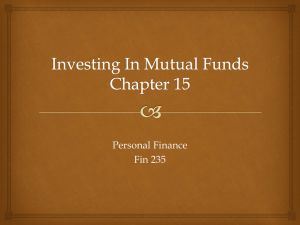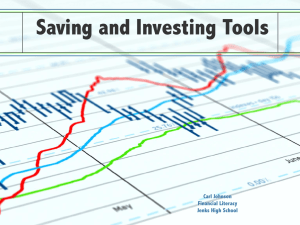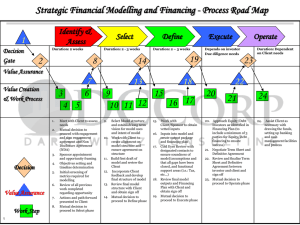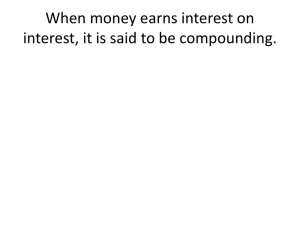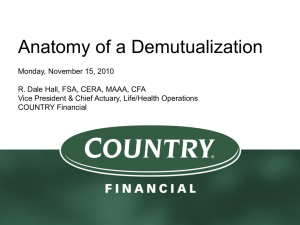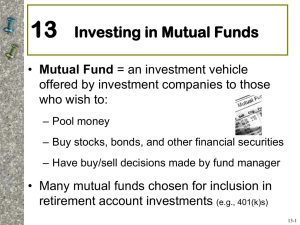Mutual Funds
advertisement
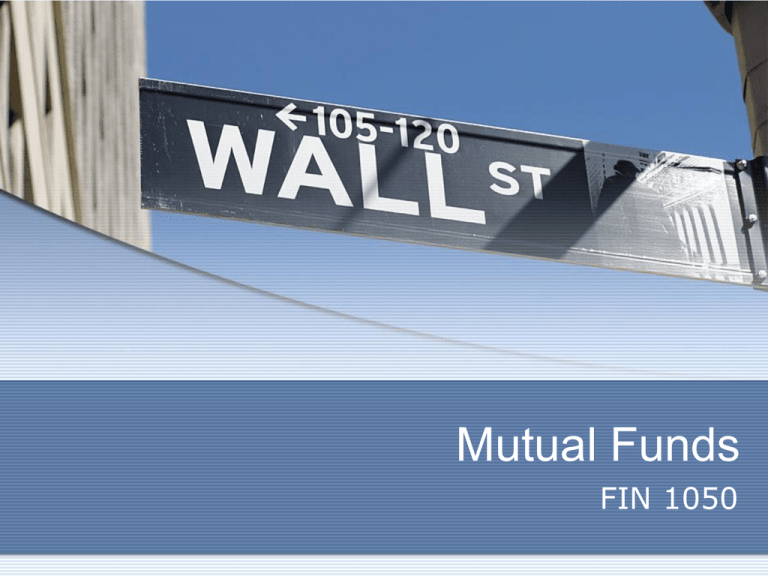
Mutual Funds FIN 1050 What We Will Cover • What is a Mutual Fund? • Advantages and Disadvantage of Mutual Funds • Costs of Mutual Funds • Types of Mutual Funds • ETFs • Buying a Mutual Fund 2 What is a Mutual Fund? • Investors pool their money • A fund manager buys a variety of stocks • Each investor owns a share of the fund (the total of all the stocks in the fund) • When the fund increases in value, the investor makes money 3 How Mutual Funds Work Individuals invest their savings in a mutual fund Mutual Fund The mutual fund invests in a wide range of stocks and bonds 4 Net Asset Value • Mutual funds do not change price throughout the trading day • The price you buy and sell for is called net asset value (NAV) rather than stock price • It is updated only once a day, at the end of the trading day • NAV equals Total value of securities minus debts divided by number of shares 5 Open-Ended Funds • This type of fund may issue as many shares as it wishes, and anyone can invest • 95% of funds are open-ended 6 Closed-End Funds • Closed-end funds can issue a limited number of shares • Investors buy and sell shares among themselves 7 Advantages of Mutual Funds • Diversification • You purchase a small amount of many stocks without having to physically buy each stock • Professional Management • Fund managers are professionals with access to better information than the average investor 8 Advantages of Mutual Funds • Minimal transaction costs • Individual investors save on brokerage fees compared to individual stock purchases • Liquidity • Easy to buy and sell • Flexibility • There are over 8000 funds to choose from, allowing you to invest in an area you want 9 Disadvantages of Mutual Funds • Lower-than-market performance • On average, mutual funds underperform the market • Costs • May charge a sales fee as well as an annual expense fee that will eat away your profits 10 Disadvantages of Mutual Funds • Risk • Depending on the segment of the market the mutual fund invests, it may do very well or very poorly • Systemic Risk • A market crash will have a negative effect on your fund • Taxes • You have to pay taxes on gains as you go, except in a retirement account 11 Costs of Mutual Funds • “Load” funds charge a commission to buy or sell the funds • Usually 4-8% of the investment • “Front-end load” means you pay a commission when you buy • “Back-end load” means you pay a commission when you sell the fund 12 Costs of Mutual Funds • “No-load” funds mean you don’t pay a sales commission, but deal directly through the investment company • Some funds will charge a fee if you sell within a specific period of time, such as 90 days 13 Costs of Mutual Funds • Owners of mutual funds pay an annual expense • Known as the expense ratio • Typically it is .25 to 2 percent of the investment value • Try to buy a fund with the lowest expense ratio possible • Expenses can eat up all or most of your profits, especially if the fund isn’t performing well 14 Costs of Mutual Funds • 12b-1 fee • These are marketing expenses passed on to the investor • They do not benefit the investor at all • Try to find funds that have minimum or no 12b-1 fees • They will eat into your profits and do not provide any benefit to the investor 15 Types of Mutual Funds • Stock funds • Most popular types of funds • They buy mostly stocks, but may also invest in cash, bonds, and money market funds 16 Types of Stock Funds • Aggressive Growth Funds • The fund buys stocks that will (hopefully) increase dramatically in price • Very volatile • Small-Company Growth Funds • Investments are limited to small companies • Volatile 17 Types of Stock Funds • Income Funds • Concentrate more on strong companies paying dividends • Less risky than aggressive growth funds • Growth-and-Income Funds • Concentrate on stocks providing dividends plus the potential for growth • Less volatile 18 Types of Stock Funds • Sector Funds • Specializes in stocks from a specific industry • Computer, financial services, biotech, etc. • Index Funds • This fund tracks a market index such as the S & P 500, the DOW, or the Nasdaq • Low expense ratio • International • Invests mostly in stocks outside the U.S. 19 Types of Mutual Funds • Balanced funds • Holds both stocks and bonds • Asset Allocation • Balanced funds with market timing • Life Cycle Funds (relatively new) • Attempt to tailor holdings to the investor’s age and risk tolerance • The fund is managed based on how close you are to retirement 20 Types of Mutual Funds • Bond funds • Invest in bonds rather than stocks • Emphasize income over growth • Types of bond fund (remember that a bond is debt issued by a company or government that must be paid back) • U.S. Government bonds • Municipal bonds (bonds issued by city or state) • Corporate bonds 21 ETFs (Exchange Traded Funds) • These are a hybrid between mutual funds and stocks • Trade throughout the day • Like a mutual fund in that they are diversified, but based on an index or sector of the marketplace • The biggest are QQQ (tracking the Nasdaq) and SPDRS (tracking the S & P 500) • Lower expenses than mutual funds 22 Buying a Mutual Fund • Determine your goals • What are you investing for? • Retirement • Education • Income • Growth • Meeting your objectives • Make sure the fund meets your goals (above) 23 Evaluate the Fund • www.morningstar.com identifies funds by investment strategy and management style • Look closely at past performance and expenses • Compare funds in the same category; do not compare a growth fund to an international fund, for example • Look for “star” ratings (4-star and 5-star ratings) 24 Buying a Mutual Fund • You can purchase through your company’s 401(k) website • You can purchase directly from the mutual fund company • You can purchase from your broker • You can purchase through your bank • Many funds will let you invest with as little as $1000 in a retirement account 25
